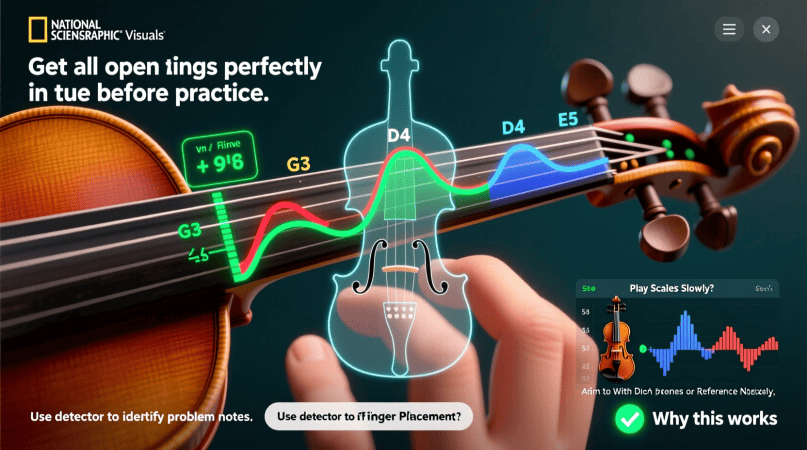
Every violinist knows the struggle—your fingers land just a little too high or too low, and suddenly the note is sharp or flat. Unlike fretted instruments, the violin gives you no visual guide. Your ear has to do the work, but in the early stages it can be hard to tell if you’re truly on pitch. This is where pitch detection tools can help. By showing you in real time whether your intonation is accurate, you can build both ear and muscle memory faster.
Why Violin Intonation Is So Tricky
- No frets or markers: Even a millimeter off changes the pitch.
- Muscle memory takes time: The left hand must “learn” exact placements.
- Ear training is gradual: Beginners often can’t hear small deviations.
Traditional advice—like practicing scales with a drone or listening to resonance—is essential. But adding visual pitch feedback makes practice more precise.
How Pitch Detection Helps
- Instant feedback: See if your note is sharp or flat as you play.
- Faster correction: Move your finger slightly and watch the pitch lock in.
- Progress tracking: Notice how your accuracy improves week by week.
- Safer learning: Spot recurring problems before they become habits.
👉 Start by mapping your open strings and first-position notes with the Voice Pitch Analyzer to establish your baseline accuracy.
Step-by-Step: Practicing With Pitch Detection
1. Tune and Test Open Strings
Play G, D, A, and E. Make sure the detector shows stable pitch. This sets your reference.
2. Practice Scales Slowly
Choose a simple scale like G major. Play one note per bow and watch the feedback. Adjust finger placement until the note centers.
👉 Use the Singing Pitch Detector in real time to confirm each pitch during scale practice.
3. Train Position Shifts
Move from first to third position. The pitch graph will reveal if you overshoot or undershoot the note. Smooth, accurate shifts are easier when you can see them.
4. Work on Double Stops
Play two notes together and check if both align with the detector. Open string + stopped note is especially helpful for finding resonance.
5. Track Your Improvement
Play the same scale daily and compare. Take screenshots or write down accuracy scores. Over time, you’ll see fewer sharp/flat notes.
Extra Tips for Better Results
- Go slow: Rushing hides intonation problems.
- Alternate ear and eye: Listen first, then confirm with pitch detection.
- Record yourself: Compare the audio with pitch graphs to spot patterns.
- Combine with drones: Layer visual and auditory references for stronger training.
Pitch Detector is a project by Ornella, blending audio engineering and web technology to deliver precise, real-time pitch detection through your browser. Designed for musicians, producers, and learners who want fast, accurate tuning without installing any software.
